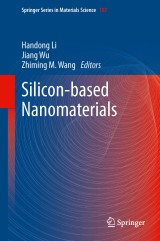Details

Silicon-based Nanomaterials
Springer Series in Materials Science, Band 187
|
149,79 € |
|
| Verlag: | Springer |
| Format: | |
| Veröffentl.: | 02.10.2013 |
| ISBN/EAN: | 9781461481690 |
| Sprache: | englisch |
| Anzahl Seiten: | 409 |
Dieses eBook enthält ein Wasserzeichen.
Beschreibungen
<p>A variety of nanomaterials have excellent optoelectronic and electronic properties for novel device applications. At the same time, and with advances in silicon integrated circuit (IC) techniques, compatible Si-based nanomaterials hold promise of applying the advantages of nanomaterials to the conventional IC industry. This book focuses not only on silicon nanomaterials, but also summarizes up-to-date developments in the integration of non-silicon nanomaterials on silicon. The book showcases the work of leading researchers from around the world who address such key questions as: Which silicon nanomaterials can give the desired optical, electrical, and structural properties, and how are they prepared? What nanomaterials can be integrated on to a silicon substrate and how is this accomplished? What Si-based nanomaterials may bring a breakthrough in this field? These questions address the practical issues associated with the development of nanomaterial-based devices in applications areas such as solar cells, luminous devices for optical communication (detectors, lasers), and high mobility transistors. Investigation of silicon-based nanostructures is of great importance to make full use of nanomaterials for device applications. Readers will receive a comprehensive view of Si-based nanomaterials, which will hopefully stimulate interest in developing novel nanostructures or techniques to satisfy the requirements of high performance device applications. The goal is to make nanomaterials the main constituents of the high performance devices of the future.</p>
<p>Preface.- Chapter 1: Porous Silicon as Anode Material for Lithium Ion Batteries.- Chapter 2: The development of Si and Ge-based nanomaterials for high performance lithium ion battery anodes.- Chapter 3: Light Trapping in Coaxial Nanowires of c-Si Cores and a-Si Shells.- Chapter 4: Applications of Ordered Si Nanowire Array to Solar Energy Harvesting and NEMS.- Chapter 5: Synchrotron-excited photoluminescence spectroscopy of silicon- and carbon-containing quantum dots in low dimensional SiO2 matrices.- Chapter 6: Silicon nanoparticles-based light emitting capacitors.- Chapter 7: Electronic and Optical Properties of Silicon Carbide Nanostructures.- Chapter 8: Plasma Enabled Fabrication of Silicon Carbide Nanostructures.- Chapter 9: Catalyst-free chemical vapor deposition for synthesis of SiC nanowires with controlled morphology.- Chapter 10: Adhesion and Indentation fracture behavior of Silicon carbonitride nanocomposite coatings deposited by Magnetron sputtering.- Chapter 11: Impact of Defects and Doping on Electron Transport in SiCNTs.- Chapter 12: Synthesis, Properties and Applications of One-Dimensional Transition Metal Silicide Nanostructures.- Chapter 13:Integration of strain free III-V quantum dots on silicon.- Chapter 14: III-V Quantum-Dot Materials and Devices Monolithically Grown on Si Substrates.- Chapter 15: Cubic GaN on Nano-patterned 3C-SiC/Si (001) Substrates.- Index.</p>
<p>A variety of nanomaterials have excellent optoelectronic and electronic properties for novel device applications. At the same time, and with advances in silicon integrated circuit (IC) techniques, compatible Si-based nanomaterials hold promise of applying the advantages of nanomaterials to the conventional IC industry. This book focuses not only on silicon nanomaterials, but also summarizes up-to-date developments in the integration of non-silicon nanomaterials on silicon. The book showcases the work of leading researchers from around the world who address such key questions as: Which silicon nanomaterials can give the desired optical, electrical, and structural properties, and how are they prepared? What nanomaterials can be integrated on to a silicon substrate and how is this accomplished? What Si-based nanomaterials may bring a breakthrough in this field? These questions address the practical issues associated with the development of nanomaterial-based devices in applications areas such as solar cells, luminous devices for optical communication (detectors, lasers), and high mobility transistors. Investigation of silicon-based nanostructures is of great importance to make full use of nanomaterials for device applications. Readers will receive a comprehensive view of Si-based nanomaterials, which will hopefully stimulate interest in developing novel nanostructures or techniques to satisfy the requirements of high performance device applications. The goal is to make nanomaterials the main constituents of the high performance devices of the future.</p><ul><li>Describes today’s most promising approach to the full use of nanomaterials in device applications</li><li>Provides the keys to understanding the integration of nanomaterials with silicon ICs </li><li>Addresses both materials growth and properties </li><li>Covers both silicon and non-siliconnanomaterials </li><li>Written by leading experts in each research area</li></ul>
Describes today’s most promising approach to the full use of nanomaterials in device applications Provides the keys to understanding the integration of nanomaterials with silicon ICs Addresses both materials growth and properties Covers both silicon and non-silicon nanomaterials Written by leading experts in each research area
Diese Produkte könnten Sie auch interessieren:

Neutron Applications in Earth, Energy and Environmental Sciences

von: Liyuan Liang, Romano Rinaldi, Helmut Schober

149,79 €

Nanobioelectronics - for Electronics, Biology, and Medicine

von: Andreas Offenhäusser, Ross Rinaldi

96,29 €














